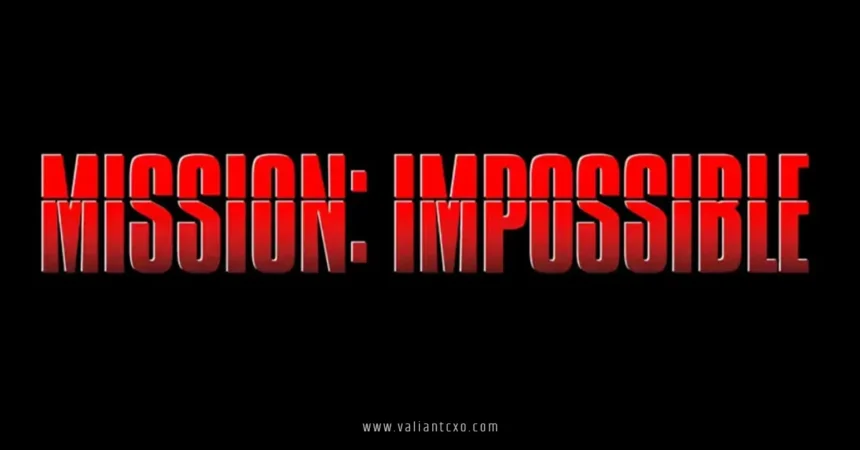Mission Impossible—the name alone sparks images of heart-pounding action, clever disguises, and Tom Cruise defying gravity in ways that make your palms sweat. Since its debut in 1996, the Mission Impossible franchise has redefined the spy thriller genre, blending high-octane stunts with intricate plots that keep audiences glued to their seats. But what makes Mission Impossible such a cultural juggernaut? Is it the jaw-dropping action sequences, the charismatic Ethan Hunt, or the way each film pushes the boundaries of what’s possible? Let’s dive into the world of Mission Impossible, exploring its history, impact, and why it continues to captivate fans worldwide.
The Birth of Mission Impossible: A Legacy Begins
Picture a world where espionage was less about gadgets and more about raw grit. That’s where Mission Impossible began, inspired by the 1966 TV series created by Bruce Geller. The show, known for its self-destructing mission briefings and team-based covert operations, laid the groundwork for what would become a cinematic powerhouse. Fast forward to 1996, when director Brian De Palma brought Mission Impossible to the big screen, introducing Ethan Hunt (Tom Cruise) as the fearless IMF (Impossible Missions Force) agent.
Why did this film strike such a chord? It wasn’t just the star power—though Cruise’s charisma didn’t hurt. The movie’s iconic vault scene, where Ethan dangles from a wire in a high-security room, set a new standard for suspense. It was like watching a tightrope walker perform without a net. That moment alone cemented Mission Impossible as a franchise that thrives on making the impossible feel real.
Why Mission Impossible Stands Out in the Spy Genre
The spy genre is crowded with suave agents and high-tech gadgets, so what sets Mi-ss-ion Im-po-ssi-ble apart? For one, it’s the franchise’s commitment to practical stunts. While other films lean on CGI, Mission Impossible doubles down on real-world action. Tom Cruise climbing the Burj Khalifa in Mission: Impossible – Ghost Protocol? That was him, 2,700 feet above Dubai, no green screen needed. It’s this dedication to authenticity that makes every heart-stopping moment feel visceral.
Then there’s the storytelling. Each Mission Impossible film balances complex plots with emotional stakes. Whether it’s Ethan Hunt saving the world from a nuclear threat or protecting his team from betrayal, the stakes always feel personal. The franchise doesn’t just throw explosions at you; it makes you care about the people dodging them. Add to that the iconic self-destructing mission messages—“This message will self-destruct in five seconds”—and you’ve got a formula that’s as addictive as it is thrilling.
Evolution of Mission Impossible: From 1996 to Today
The Mission Impossible series has evolved dramatically over nearly three decades. The first film was a taut, cerebral thriller, heavy on suspense and light on explosions. By the time Mission: Impossible – Fallout hit theaters in 2018, the franchise had embraced blockbuster spectacle without losing its soul. Each movie feels like a new chapter in Ethan Hunt’s saga, with directors like J.J. Abrams, Brad Bird, and Christopher McQuarrie bringing their unique flair.
Take Mission: Impossible – Dead Reckoning Part One (2023), for instance. It’s a masterclass in balancing action with character development. The train sequence—where Ethan races across a collapsing bridge—is the kind of scene that leaves you gripping your armrest. Yet, it’s the quieter moments, like Ethan’s interactions with his team, that give the film heart. Mission Impossible doesn’t just evolve; it reinvents itself, keeping fans guessing about what’s next.
The Role of Tom Cruise in Mission Impossible’s Success
Let’s talk about the man himself: Tom Cruise. At 60-plus, he’s still performing stunts that would make most actors retire. His commitment to Mission Impossible is legendary—whether he’s hanging off a plane in Rogue Nation or learning to pilot a helicopter for Fallout. Cruise isn’t just the star; he’s the franchise’s beating heart. His portrayal of Ethan Hunt blends vulnerability with unshakable resolve, making you root for him even when the odds seem, well, impossible.
But it’s not just about the stunts. Cruise’s involvement as a producer ensures that every Mi-ss-ion Im-po-ss-ible film pushes the envelope. He’s like a chef who keeps tweaking the recipe, making each dish bolder and more flavorful. Without his vision, Mission Impossible might have faded into obscurity like so many other action franchises.
The Stunts That Define Mission Impossible
If Mi-ss-ion Im-po-ss-ible is a rollercoaster, its stunts are the loops and drops that make you scream. Each film ups the ante, delivering sequences that are equal parts insane and awe-inspiring. Here are a few that stand out:
- The Vault Scene (Mission: Impossible, 1996): Ethan’s wire-dangling infiltration is the blueprint for the franchise’s tension-filled moments.
- Burj Khalifa Climb (Ghost Protocol, 2011): Watching Cruise scale the world’s tallest building is like seeing a human defy physics.
- Motorcycle Chase (Dead Reckoning Part One, 2023): Ethan’s high-speed pursuit through narrow streets is a masterclass in controlled chaos.
These stunts aren’t just for show. They’re storytelling tools, showcasing Ethan’s determination and the stakes of each mission. Every leap, crash, and explosion feels earned, not gratuitous. That’s why Mission Impossible remains the gold standard for action cinema.
The Tech and Gadgets of Mission Impossible
No spy franchise is complete without gadgets, and Mi-ss-ion Im-po-ss-ible delivers in spades. From exploding gum to voice-altering masks, the IMF’s tech is as creative as it is cool. But unlike some spy films where gadgets steal the show, Mission Impossible uses them sparingly, letting human ingenuity take center stage. The masks, for instance, aren’t just plot devices; they’re metaphors for the deception and trust at the heart of espionage.
The franchise also keeps its tech grounded. While James Bond might have an invisible car, Mission Impossible’s gadgets feel plausible—like something a real spy agency might dream up. This realism adds to the franchise’s credibility, making every mission feel like it could actually happen.
Mission Impossible’s Cultural Impact
Mission Impossible isn’t just a movie series; it’s a cultural phenomenon. Its influence stretches beyond cinema, shaping how we think about spies, action, and even teamwork. The phrase “this is your mission, should you choose to accept it” has become a pop culture staple, parodied everywhere from sitcoms to memes. It’s like a catchy song you can’t stop humming.
The franchise has also inspired countless imitators, but none match its blend of brains and brawn. By prioritizing practical effects and character-driven stories, Mission Impossible has set a benchmark that few can touch. It’s no wonder that films like Mission: Impossible – Fallout have earned critical acclaim, with a 97% approval rating on Rotten Tomatoes.
The Team Behind Mission Impossible
While Ethan Hunt is the face of Mi-ss-ion Im-po-ss-ible, the IMF team steals the show. Characters like Luther Stickell (Ving Rhames), Benji Dunn (Simon Pegg), and Ilsa Faust (Rebecca Ferguson) bring humor, heart, and grit to every mission. Their chemistry feels like a family reunion—dysfunctional at times, but fiercely loyal. Each team member complements Ethan’s skills, making the impossible possible through teamwork.
This ensemble approach sets Mission Impossible apart from lone-wolf spy stories. It’s not just about one hero; it’s about a group of misfits who trust each other with their lives. That dynamic keeps the franchise fresh, even after eight films.
The Music That Powers Mission Impossible
You can’t think of Mission Impossible without hearing that theme song. Lalo Schifrin’s iconic score, with its urgent, pulsing rhythm, is the heartbeat of the franchise. It’s like a musical adrenaline shot, instantly putting you in the mood for espionage. Each film builds on this legacy, with composers like Hans Zimmer and Joe Kraemer adding their own flair while honoring the original.
The music doesn’t just set the tone; it amplifies the stakes. Whether it’s a quiet moment of tension or a full-throttle chase, the score makes every scene feel larger than life. It’s no surprise that the Mission Impossible theme is one of the most recognizable in film history.
What’s Next for Mission Impossible?
With Mission: Impossible – Dead Reckoning Part Two slated for release in 2025, the franchise shows no signs of slowing down. Early buzz suggests it’ll be another game-changer, with even bigger stunts and deeper emotional stakes. Will Ethan Hunt finally face a mission he can’t complete? Or will he once again defy the odds? One thing’s for sure: Mission Impossible will keep pushing the boundaries of what’s possible.
The franchise’s future also hinges on its ability to evolve. As new directors and actors join the fold, Mission Impossible must balance its signature style with fresh ideas. Given its track record, it’s a safe bet that the series will continue to thrill audiences for years to come.
Why Mission Impossible Resonates with Audiences
At its core, Mission Impossible is about defying the odds. Ethan Hunt isn’t a superhero; he’s a human who refuses to give up, no matter how stacked the deck is against him. That relatability is what makes the franchise so enduring. We’ve all faced our own “impossible” missions—whether it’s a tough job, a personal struggle, or a dream that feels out of reach. Ethan’s tenacity inspires us to keep going.
The franchise also taps into our love of adventure. Each film is a global thrill ride, taking us from Paris to Dubai to the cliffs of Norway. It’s like a travel brochure for adrenaline junkies, with every location serving as a backdrop for unforgettable action.
Conclusion: The Enduring Legacy of Mission Impossible
Mi-ss-ion Im-po-ss-ible is more than a movie franchise—it’s a testament to human ingenuity, teamwork, and the thrill of beating the odds. From its humble beginnings as a TV series to its status as a global blockbuster, Mission Impossible has redefined what action movies can be. With unforgettable stunts, compelling characters, and a knack for reinvention, it’s no wonder the series continues to captivate audiences. So, the next time you hear that iconic theme, buckle up—because Mission Impossible is ready to take you on a ride you won’t forget. Want to dive deeper into the world of espionage? Check out the films, rewatch the classics, and see why Mission Impossible remains a cut above the rest.
FAQs About Mission Impossible
1. What inspired the Mission Impossible franchise?
The Mission Impossible franchise was inspired by the 1966 TV series created by Bruce Geller, which focused on a team of covert agents tackling high-stakes missions. The films adapted this concept, amplifying the action and centering on Ethan Hunt.
2. Why is Tom Cruise so important to Mission Impossible?
Tom Cruise’s dedication to performing his own stunts and his role as a producer make him the driving force behind Mission Impossible. His commitment to authenticity elevates every film, making the action feel real and gripping.
3. What are some of the most iconic stunts in Mission Impossible?
Iconic Mission Impossible stunts include the vault scene in the first film, the Burj Khalifa climb in Ghost Protocol, and the motorcycle chase in Dead Reckoning Part One. Each pushes the limits of practical action.
4. How does Mission Impossible balance action and story?
Mission Impossible weaves emotional stakes and character-driven plots into its high-octane action. The films focus on Ethan Hunt’s loyalty to his team, making every explosion and chase feel meaningful.
5. Where can I learn more about the Mission Impossible films?
For deeper insights, check out IMDb’s Mission Impossible page for cast details, Box Office Mojo for box office stats, or Empire Online for detailed reviews.
Click Here:valiantcxo.com


